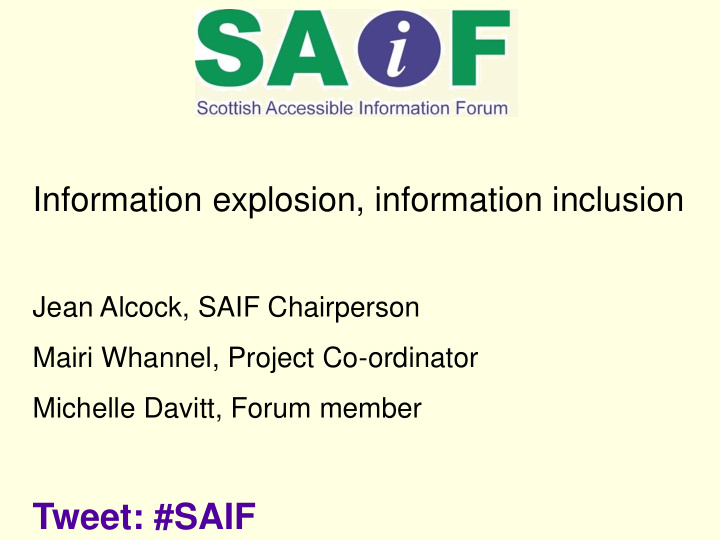



Information explosion, information inclusion Jean Alcock, SAIF Chairperson Mairi Whannel, Project Co-ordinator Michelle Davitt, Forum member Tweet: #SAIF
Accessible Information • Get your message across to your intended audience. • Include everyone who might need/want your information. • Informed choice. • User engagement. • Keep within the Law.
Ways to access information • Reading – Paper documents – with/without images – On-screen – computers/mobiles/tablets • Listening – Spoken Word – phone/radio/audio recording – Electronic Speech – Screen-reading software • Watching (+/- Listening) – Audio-visual – Face-to-Face/DVD – British Sign Language (BSL)/Makaton • Touch – braille/Moon
Accessibility Issues • Comprehension – understanding written/spoken information • Visual – difficulties reading text, e.g. dyslexia/poor eye/brain co-ordination – visual impairment • Hidden – unstructured electronic information – inaccessible to screen-reading software
Ways to improve accessibility • Language and punctuation • Layout • Text and Printing • Structure
Language and Punctuation • Use words your intended audience will understand. • Avoid jargon as much as possible. • Explain unavoidable jargon. • Use abbreviations and acronyms sparingly, and put them in full first time. • Use correct grammar and punctuation. • Use images to support meaning.
Layout • Left alignment • Short paragraphs • Space between paragraphs • Wide margins • Bullets points to break up text • Text and images separated
Text and Printing • Non-serif font e.g. Arial. • Good size print e.g. Arial 14 (12 minimum). • Good contrast between text and background. • Non-glossy paper. • Avoid blocks of text in Italics or UPPER CASE.
Structure • Use styles to create Headings • Use formatting option to create space between paragraphs • Give pictures and graphs an alternative title • Create tables using Table Tools – do not split or merge cells • Give a unique text for Links – not ‘more’ or ‘here’
Appointment letter exercise
Scenario exercise You have been asked to write an accessible information strategy for your organisation. 1. Who you would work with internally and externally to achieve this aim? 2. How would you identify and keep tabs on the specific information needs of customers? 3. How would you go about ensuring staff are aware of and follow the procedures that have been agreed? 4. What would be the main barriers and constraints to achieving this aim?
Information Strategy • Embed accessible information in all policies and procedures • Identify someone responsible • Implement staff training • Introduce a set of standards • Involve service users • Do not just ‘add - on’ accessibility
Feedback
Contact us Telephone: 0141 559 5021 Email: saifscotland@scvo.org.uk Website: www.saifscotland.org.uk Twitter: @saifscotland Tweet: #SAIF
Recommend
More recommend